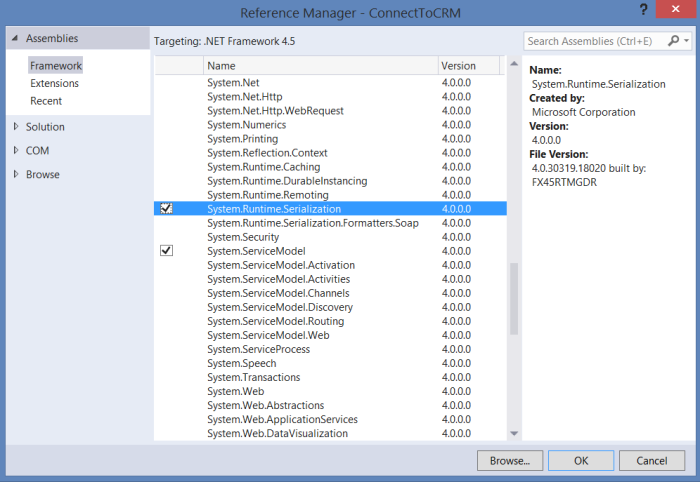Let us see a simple example to retrieve records using Query Expression,
Task: Get a Contact record with the following values, where Full Name = Arun Potti
Solution: Follow the below Steps,
Step 1: Include the below References in your project, you can get the same from Latest SDK.
Goto the path, SDK -> Bin for the dlls
Microsoft.Crm.Sdk.Proxy
Microsoft.Xrm.Sdk
Step 2: Include the below Framework Assemblies in your project,
Step 3: Add the below namespaces in your class file,
using Microsoft.Crm.Sdk.Messages;
using Microsoft.Xrm.Sdk;
using Microsoft.Xrm.Sdk.Client;
using System.ServiceModel.Description;
using Microsoft.Xrm.Sdk.Query;
Step 4: First we have to connect to CRM, for details
Click Here
Step 5: User the below method to retrieve record, and it accepts the below parameters
private static EntityCollection GetEntityCollection(IOrganizationService service, string entityName, string attributeName, string attributeValue, ColumnSet cols)
{
QueryExpression query = new QueryExpression
{
EntityName = entityName,
ColumnSet = cols,
Criteria = new FilterExpression
{
Conditions =
{
new ConditionExpression
{
AttributeName = attributeName,
Operator = ConditionOperator.Equal,
Values = { attributeValue }
}
}
}
};
return service.RetrieveMultiple(query);
}
Final usage of the function is as follows,
EntityCollection ec = GetEntityCollection(_service, "contact", "fullname", "Arun Potti", new ColumnSet("fullname", "parentcustomerid", "gendercode", "birthdate", "creditlimit", "donotsendmm"));
Step 6: Final Code is here,
using System;
using System.Collections.Generic;
using System.Linq;
using System.Text;
using System.Threading.Tasks;
using Microsoft.Crm.Sdk.Messages;
using Microsoft.Xrm.Sdk;
using Microsoft.Xrm.Sdk.Client;
using System.ServiceModel.Description;
using Microsoft.Xrm.Sdk.Query;
namespace Retrieve_Record
{
class Program
{
static IOrganizationService _service;
static void Main(string[] args)
{
EntityCollection ec = null;
ConnectToMSCRM("arunpotti@XXXXXX.onmicrosoft.com", " XXXXXX", "https:// XXXXXX.api.crm5.dynamics.com/XRMServices/2011/Organization.svc");
Guid userid = ((WhoAmIResponse)_service.Execute(new WhoAmIRequest())).UserId;
if (userid == Guid.Empty) return; //Check for CRM Connection Establishment. If Not return, other wise will proceed to next step
ec = GetEntityCollection(_service, "contact", "fullname", "Arun Potti", new ColumnSet("fullname", "parentcustomerid", "gendercode", "birthdate", "creditlimit", "donotsendmm"));
if(ec.Entities.Count > 0) //Check for EntityCollection count
{
string output = string.Empty;
foreach (var item in ec.Entities)
{
//String
if (item.Attributes.Contains("fullname")) //Check for fullname value exists or not in Entity Collection
output += "Full Name : " + item.Attributes["fullname"] + "\n";
//Lookup
if (item.Attributes.Contains("parentcustomerid")) //Check for parentcustomerid exists or not in Entity Collection
output += "Company : " + ((EntityReference)item.Attributes["parentcustomerid"]).Name + "\n";
//OptionSet
if (item.Attributes.Contains("gendercode")) //Check for gendercode exists or not in Entity Collection
output += "Gender : Name - " + item.FormattedValues["gendercode"] + ", Value - " + ((OptionSetValue)item.Attributes["gendercode"]).Value + "\n";
//Date
if (item.Attributes.Contains("birthdate")) //Check for birthdate exists or not in Entity Collection
output += "Birthday : " + ((DateTime)item.Attributes["birthdate"]).ToLocalTime().ToShortDateString().ToString() + "\n";
//Currency
if (item.Attributes.Contains("creditlimit")) //Check for creditlimit exists or not in Entity Collection
output += "Credit Limit : " + ((Money)item.Attributes["creditlimit"]).Value + "\n";
//Two Options
if (item.Attributes.Contains("donotsendmm")) //Check for donotsendmm exists or not in Entity Collection
output += "Send Marketing Materials : Name - " + item.FormattedValues["donotsendmm"] + ", Value - " + ((Boolean)item.Attributes["donotsendmm"]).ToString();
}
Console.WriteLine(output);
Console.ReadKey();
}
}
private static void ConnectToMSCRM(string UserName, string Password, string SoapOrgServiceUri)
{
try
{
ClientCredentials credentials = new ClientCredentials();
credentials.UserName.UserName = UserName;
credentials.UserName.Password = Password;
Uri serviceUri = new Uri(SoapOrgServiceUri);
OrganizationServiceProxy proxy = new OrganizationServiceProxy(serviceUri, null, credentials, null);
proxy.EnableProxyTypes();
_service = (IOrganizationService)proxy;
}
catch (Exception ex)
{
Console.WriteLine("Error while connecting to CRM " + ex.Message);
Console.ReadKey();
}
}
private static EntityCollection GetEntityCollection(IOrganizationService service, string entityName, string attributeName, string attributeValue, ColumnSet cols)
{
QueryExpression query = new QueryExpression
{
EntityName = entityName,
ColumnSet = cols,
Criteria = new FilterExpression
{
Conditions =
{
new ConditionExpression
{
AttributeName = attributeName,
Operator = ConditionOperator.Equal,
Values = { attributeValue }
}
}
}
};
return service.RetrieveMultiple(query);
}
}
}
Step 7: You can see the below output,





